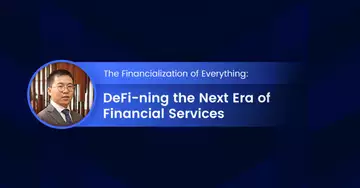There are many misconceptions about DeFi (decentralized finance). Perhaps the most important is that Defi wants to replace traditional finance. It doesn't. Rather, DeFi is a way to exponentially expand the reach of existing financial services and must be seen as a complement to TradFi, not a replacement for it.
One way to think of this is to look at the evolution of cell phones into smartphones. Before the development of apps, cell phones could only do one or two things - they allowed you to make and receive calls on the go and send an occasional text message. But when the app store came to life in 2005, it was like a Cambrian explosion, and a million new apps were developed. The key to this explosion was that it wasn't dictated from above; it was transparent and open to everyone.
DeFi is transparent and permissionless, and as such, it will evolve quickly as well. No one really knows how it will end up, but it is already an unstoppable trend. One of the key elements of DeFi is that it can move into areas not covered by TradFi. First, it can create an underlying for assets that have been untouched by the financial world. It can make these assets liquid and fungible so they can be used for transactions in the traditional sense, such as collateral for loans or margin for trading.
By extending finance to a much broader range of categories, a much broader range of assets can also be given financial rights. This is what we mean by the term financialization of everything.
We have seen this process before. The great Peruvian economist Hernando de Soto pioneered the study of the extension of property rights and titles to the poor. In his book, The Secret of Capital, he showed how the extension of property rights to even the smallest piece of land or dwelling provided the poor with an asset they could finance by pledging it as collateral for loans to build businesses and escape the poverty trap. DeFi has the same transformative potential.
DeFi will be adopted at different rates in this new era of financial services. Clearly, it will be better adopted in countries with weak economies and poor financial infrastructure. These poor countries have much greater incentives to find ways to grow the financial base of their economies. DeFi will allow them to broaden their asset base and address the structural limitations of their existing financial systems. It is no surprise that there are already more people in the Philippines with MetaMask accounts than with bank accounts.
The only thing DeFi is removing is barriers. But it's still in the very early stages of development. And as with all new technologies that are in early stages of development, it can still be complicated to use and the user experience can be cumbersome. For general users, it's complicated to get started entering smart contracts and writing logs.
"People are willing to pay for what they need," says John Ge, founder and CEO of Matrixport. "They also don't have the skills to interact directly with smart contracts - it's too complex. If we want to attract more people to DeFi, we need to make it as simple as possible."
DeFi needs intermediaries. And we expect the next wave of activity in the DeFi sector to be on the customer side rather than the technical development side. Making DeFi as user-friendly as an app store will be the next step in development.
Matrixport offers such access to invest directly in DeFi with a few clicks in its app and with full transparency on returns. The centralized DeFi offering bundles a basket of liquidity mining projects from established players such as Uniswap, Cure and Compound. The simplicity of the platform is built on solid research, monitoring and security checks of the underlying data protocols. This has made Matrixport's DeFi offering popular in market neutral times when investors are looking for stable returns.

